Highlights Templelhoffer Feld and strawberries
with Axel
Axel arrived a little early for our 9am pickup
so joined us for coffee in the apartment.
He then gave us his plan for the day
and some German/Berlin history. We had seen a lot of mentions of Charlottesburg
as the area we are in and he told us it had been a village that is now part of
the Berlin area as Berlin has grown.
He explained the wide avenues in Berlin go back
to the Prussian leader of the time, Fritz, who wanted his army to have men of
over 6 feet. The roads had to be wide enough for 8 men to march abreast and
farmers were told to plant trees on both sides to give them shade. Berlin has
680 000 trees on streets and more in parks. After hearing this we were very
aware of the greenness of the city.
He also told us a bit more about life in West
Berlin in the past. He said that many students came here during the time of
partition as studying here would exempt you from the 1.5 years of compulsory
military service. There were also tax advantages to encourage other residents.
The city had had a lot of spare housing space after the wall came down but then
the decision was made to make Berlin the capital. This was a major cause of
revival and now accommodation is scarce. There are 3.6 million people in Berlin
now.
He pointed out the unrestored church near
KaDeWe and told us of the decision made to leave it in this form.
His circuit took us past a number of the places
we had seen yesterday but filled in some gaps. We had seen the Tiergarten from
the outside but now were told it was originally a hunting area. During WW2 all
the trees were taken down and used for firewood and many parts planted in food
crops.
After the war it was replanted in trees so now none are more than 65
years old.
The significance of the year was pointed out to
us when we stopped at the Eastside Gallery. The wall stood for 29 years and it is
now 29 years since it came down. We did another short visit to the gallery and
took a few more photos on what was proving to be a much sunnier day.
Axel had given us maps, but I still got a bit
lost as to where we actually were at times. As we could not often stop to take
photos, the following are my main memories.
The houses were often first built in close rows
with many houses hence having little sun. Many of the areas have had every
second row removed so they now have space. Axel stopped and showed us an alley
with the houses behind as he had described.
We saw the Congress building, given by America,
and known by locals as the ‘pregnant oyster’. We went past the Hotel Adlon, the
hotel that visiting dignitaries often stay in. We heard about the Schloss. The
first one had been demolished and replaced by a republican building.
That has
now been pulled down and a new one is being rebuilt to match the original.
We were advised to go up the TV tower for the
views, and told that a cross appears on it when the sun strikes it at times. This
was an embarrassment to the East German government who were very keen to
undermine any religious symbols of power. Having built it, they did not want to
remove it.it is called the Pope’s Revenge.
We were then taken through the Turkish area.
This had been a cheap place to live but was getting more expensive, and
students were moving in.
We then went to the airport used in the famous Berlin
airlift which kept Berlin afloat during the Soviet blockade from 24 June
1948–12 May 1949. During this time an aircraft landed every minute to supply
the people of West Berlin. Axel told us the area is now a public park. Although
the authorities had been eyeing it as an area for development, a public protest
and later vote has left it for recreation. Even on a Friday there were people
cycling, picnicking and playing in the area.
It is very popular at the weekend
we were told. It is of course huge (the largest building in Europe), and the
old runways are good for cycling. The buildings had been used recently as
temporary accommodation for refugees. It is quite incredible to see the scale
of the structure here and then to realise it is completely empty!!
The history of the area was explained on a
pamphlet Axel picked up for us. Templehofer Feld dates to the 13th
century when it was the headquarters of the Knights Templar. It was later the parade ground for the King
of Prussia and later an area where early aviators practised. The civil airport
was built in 1923 and the Nazis built anther building on the site. There is a
commemoration trail here but we did not have time to do it
We drove past the area where Axel grew up and he pointed out the
hill he used to sled down. It had been formed from the rubble post war and
covered later in dirt. Axel was born in 1950 and remembers one demolished
building. His wife was born in 1943 and remembers a lot of ruined buildings.
We stopped for lunch in a nice local pub where Axel regularly
meets friends to play cards. We enjoyed eating in the open at a place we would
never have found by ourselves.
Next on the agenda was a visit to the Wannsee area from which
you can access Peacock Island. We did not have time to go to the island but
enjoyed the leg stretch by the shore. Peacock Island is a World Heritage site
that can only be visited by day. It has peacocks on it but also lots of other
wild life. Its main feature is a little white
palace, set in a prominent clearing at the end of the island. It was built in
the late 18th century and survived the WW2 bombing.
Axel then took us past the famous Potsdam Spy
Bridge, although we could not stop on it of course. By them it was after 2pm
and the traffic was noticeably worse. We were told this s usually form 3pm but
2pm because it was Friday. His attempt to drive past Sanssouci Palace was
aborted and we headed for his home. John was very pleased because, although interesting,
it was now over 30 degrees even in the car (33.
5C JB)
Ursula, his wife, is a talented artist who now
often uses her skills with photography. She has her books of NZ and Berlin on the
table for us to look at. Axel says she may take 100 photos a day, discard some
on her travels and then deletes more when she gets to a computer. By the time
she makes her book of them, she is down to 60 photographs to represent her
trip, so they are great.
We admired some and then went on a tour of the
house and grounds. Ursula is also a keen gardener and it showed. We were
admiring also her book of their recent trip to the Dominica Republic while
being served coffee and ice-cream. Strawberries ice-cream and a wafer were
perfect on a hot afternoon. We sadly, but wisely decided to sit inside in the
relative cool as usually being in the gardens would have been lovely.
After a wide-ranging conversation about family,
work, travel and the impact of refugees in Germany Axel took us home. John and
I went to a different supermarket to supplement our deli supplies for another
meal on the terrace. Then we walked to a local cache at a statue of Bismarck as
the sun was setting. It is lovely to have the long evenings.

 Berlin, Berlin, Germany
Berlin, Berlin, Germany
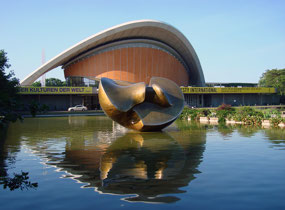
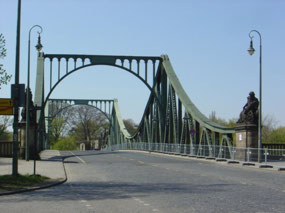
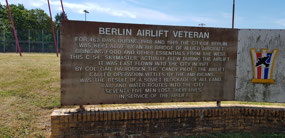
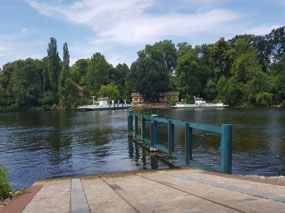
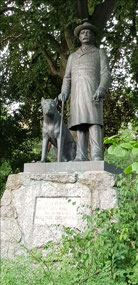







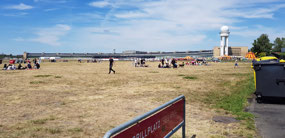
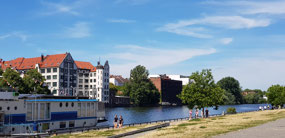
2025-05-22